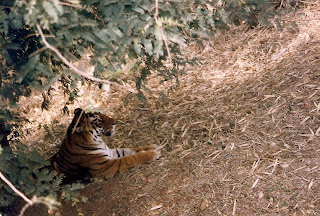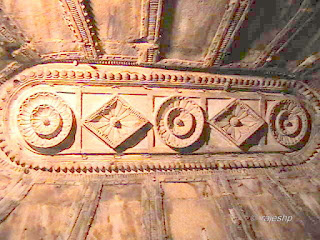Hampi is a rock garden where you will see rocks for miles as far as your eyes can gaze. One can see rocks of all sizes and shapes all around. Some of them have given shape to construct beautiful temples and carvings. (Click on all the images for bigger picture)
 There are two such natural rocks which have been not given any shape and they can be seen even today as they were from ages. These rocks can be seen on the way to Kamalapur, which is 4 kms away from Hampi . The interesting aspect of these Sister Rocks (popularly known as Akka – Thangi Betta) is they lean against each other and touch each other only at the top tip. Local legend has it that two sisters were walking towards Hampi and the were very tired and the weather was very dry. As a result they insulted Hampi and they were cursed to become rocks.
There are two such natural rocks which have been not given any shape and they can be seen even today as they were from ages. These rocks can be seen on the way to Kamalapur, which is 4 kms away from Hampi . The interesting aspect of these Sister Rocks (popularly known as Akka – Thangi Betta) is they lean against each other and touch each other only at the top tip. Local legend has it that two sisters were walking towards Hampi and the were very tired and the weather was very dry. As a result they insulted Hampi and they were cursed to become rocks.
This is the most impressive of all the temples in the Gwalior fort. This temple dates back to the 9th century, and is constructed by the Pratihar Kings. (Click on all the images for bigger picture)
 front portion
front portion This temple is dedicated to Lord Vishnu. Inside the fort this is one of the tallest structure and its height is 100ft. This temple architecture is a combination of the Dravidian (from South India) and the Indo-Aryan (North Indian). The roof is typically Dravidian but the sculptures and embellishing inside are Indo Aryan in nature.  one of the sides
one of the sides
Tiger is India's national animal. But sadly it is becoming endangered because, it is poached for its body parts to cater to an illegal market. Another reason is habitat loss due to depletion of forest cover due to interference of humans and encroachment of forest land by people causing fragmentation. Famous Bengal tiger is already declared as endangered species.
By conserving and saving tigers the entire wilderness of ecosystem is conserved. Conserving wilderness is important and crucial to maintain the life support system. Today approximately 1400 tigers are surviving in India. There are several Tiger Reserves in India but man's greed even crosses those boundaries. Please join Save our Tiger initiative. (Click on all the images for bigger picture)
 Above snap of tiger is taken at Bannerghatta National Park
Above snap of tiger is taken at Bannerghatta National Park.
This park is at a distance of around 21 kms from Bangalore city.
Back from Mitavali in Gwalior we went straight to Gwalior Fort after covering Jai Vilas Palace. (Click on all the images for bigger picture)
 The magnificent Gwalior Fort is built by rulers of Tomar Dynasty in the 15th century on a sandstone cliff, which is 2.8km long from the North to the South and 200-850m wide from east to west and 91 m above the surrounding plains. A majority portions of the fort was built during the reign of Raja Man Singh. The fort walls which are 35ft high and two miles in length, has been influenced by both Hindu and Muslim architecture.
The magnificent Gwalior Fort is built by rulers of Tomar Dynasty in the 15th century on a sandstone cliff, which is 2.8km long from the North to the South and 200-850m wide from east to west and 91 m above the surrounding plains. A majority portions of the fort was built during the reign of Raja Man Singh. The fort walls which are 35ft high and two miles in length, has been influenced by both Hindu and Muslim architecture.
This awe-inspiring fort with two main entrances, encloses three complexes, six palaces, temples and a number of water tanks. Inside the fort there are some wonders of medieval architecture. On the eastern side the fort can be approached from Eastern Gate known as Gwalior Gate which leads pedestrian path while on the western side is Urbai Gate which is the motor able way.
 The northern end has Jhangir Palace (5), Shah Jahan Palace, Karna Mahal, Vikram Mahal and Jal Johar Kund. These structures without the proper maintenance are sadly getting ruined. Gurdwara Data Bandi Chhod (6) is the new addition to the fort and has been constructed very recently. Near the Eastern Gate is Man Mandir Palace and it has been maintained quite well. Other structures that are maintained well are the temples. In the next sections we will cover the following in some detail:
The northern end has Jhangir Palace (5), Shah Jahan Palace, Karna Mahal, Vikram Mahal and Jal Johar Kund. These structures without the proper maintenance are sadly getting ruined. Gurdwara Data Bandi Chhod (6) is the new addition to the fort and has been constructed very recently. Near the Eastern Gate is Man Mandir Palace and it has been maintained quite well. Other structures that are maintained well are the temples. In the next sections we will cover the following in some detail:
- Man Mandir Palace
- Sahastrabahu Temple
- Teli-Ka Mandir
- Gujari Mahal
 It is located 5 kms from city center. This is a very new temple and was constructed in 1988. It is inspired by architecture of the famous Konark Temple in Orissa.
It is located 5 kms from city center. This is a very new temple and was constructed in 1988. It is inspired by architecture of the famous Konark Temple in Orissa. The exterior of temple uses red stone while the interior uses white marble. There is a beautiful sculpture of Lord Surya in the temple. The carvings on the exterior of the temple depict various Hindu Gods and they have been carved beautifully.
The exterior of temple uses red stone while the interior uses white marble. There is a beautiful sculpture of Lord Surya in the temple. The carvings on the exterior of the temple depict various Hindu Gods and they have been carved beautifully. Even though this temple is pretty new it attracts lot of visitors. The temple premises has a beautiful garden and is a nice place to relax.
Even though this temple is pretty new it attracts lot of visitors. The temple premises has a beautiful garden and is a nice place to relax.





















